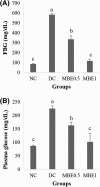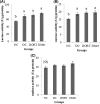Anti-diabetic effects of mulberry (Morus alba L.) branches and oxyresveratrol in streptozotocin-induced diabetic mice
- PMID: 30263707
- PMCID: PMC6049727
- DOI: 10.1007/s10068-017-0223-y
Anti-diabetic effects of mulberry (Morus alba L.) branches and oxyresveratrol in streptozotocin-induced diabetic mice
Abstract
Despite with accumulating evidences on the anti-diabetic effects of mulberry branch (MB), the major active component for the activity has not been known. Oral administration of MB ethanol (EtOH) extracts [0.5 or 1 g/kg body weight (BW)] once a day for 22 days to streptozotocin-induced diabetic ICR mouse significantly reduced fasting blood and plasma glucose level in a dose dependent manner compared to those of the diabetic control. Administration of oxyresveratrol [ORT, 0.6 g/kg BW], a major compound of MB EtOH extracts, to diabetic ICR mouse also significantly reduced fasting plasma glucose level. Further, ORT increased hepatic glucose transporter 2 transcription and glycogen content. Plasma insulin concentration and intestinal disaccharidase activity were not different between diabetic control and ORT groups. This suggests that ORT reduced plasma glucose by stimulating hepatic glucose uptake and glycogen storage. MB EtOH extracts and ORT could be potential adjunct therapies for diabetes management.
Keywords: Diabetes; Mouse; Mulberry branch; Oxyresveratrol; Streptozotocin.
Conflict of interest statement
Compliance with ethical standardsAll authors declare that they have no conflict of interest.
Figures






Similar articles
-
The Effects of Supplementary Mulberry Leaf (Morus alba) Extracts on the Trace Element Status (Fe, Zn and Cu) in Relation to Diabetes Management and Antioxidant Indices in Diabetic Rats.Biol Trace Elem Res. 2016 Nov;174(1):158-165. doi: 10.1007/s12011-016-0696-1. Epub 2016 Apr 13. Biol Trace Elem Res. 2016. PMID: 27071614 Free PMC article.
-
Flavonoids extracted from mulberry (Morus alba L.) leaf improve skeletal muscle mitochondrial function by activating AMPK in type 2 diabetes.J Ethnopharmacol. 2020 Feb 10;248:112326. doi: 10.1016/j.jep.2019.112326. Epub 2019 Oct 19. J Ethnopharmacol. 2020. PMID: 31639486
-
Effects of unaltered and bioconverted mulberry leaf extracts on cellular glucose uptake and antidiabetic action in animals.BMC Complement Altern Med. 2019 Mar 6;19(1):55. doi: 10.1186/s12906-019-2460-5. BMC Complement Altern Med. 2019. PMID: 30841887 Free PMC article.
-
Mulberry leaf extract restores arterial pressure in streptozotocin-induced chronic diabetic rats.Nutr Res. 2009 Aug;29(8):602-8. doi: 10.1016/j.nutres.2009.06.002. Nutr Res. 2009. PMID: 19761895
-
Phytochemistry, pharmacology, and clinical trials of Morus alba.Chin J Nat Med. 2016 Jan;14(1):17-30. doi: 10.3724/SP.J.1009.2016.00017. Chin J Nat Med. 2016. PMID: 26850343 Review.
Cited by
-
Unearthing the Potential Therapeutic Effects of Oxyresveratrol Based on Intrinsic Links between Pharmacological Effects: Implications for the Gut-Liver-Brain Axis.Pharmaceuticals (Basel). 2024 Aug 13;17(8):1063. doi: 10.3390/ph17081063. Pharmaceuticals (Basel). 2024. PMID: 39204169 Free PMC article. Review.
-
Evaluating the Cytotoxic Effect of Melatonin and Oxyresveratrol on Dental Pulp Stem Cells.Eurasian J Med. 2023 Feb;55(1):32-36. doi: 10.5152/eurasianjmed.2023.21270. Eurasian J Med. 2023. PMID: 36861863 Free PMC article.
-
Anti-Hyperglycemic Effects of Thai Herbal Medicines.Plants (Basel). 2024 Oct 13;13(20):2862. doi: 10.3390/plants13202862. Plants (Basel). 2024. PMID: 39458809 Free PMC article.
-
Inhibitory effect of Artocarpus lakoocha Roxb and oxyresveratrol on α-glucosidase and sugar digestion in Caco-2 cells.Heliyon. 2020 Mar 2;6(3):e03458. doi: 10.1016/j.heliyon.2020.e03458. eCollection 2020 Mar. Heliyon. 2020. PMID: 32154416 Free PMC article.
-
Mori Ramulus Inhibits Pancreatic β-Cell Apoptosis and Prevents Insulin Resistance by Restoring Hepatic Mitochondrial Function.Antioxidants (Basel). 2021 Jun 3;10(6):901. doi: 10.3390/antiox10060901. Antioxidants (Basel). 2021. PMID: 34204891 Free PMC article.
References
-
- Hur J. DongeubogamDongeuhak Institute. Seoul, Korea: Ryogang; 1994. pp. 2803–2805.
LinkOut - more resources
Full Text Sources
Other Literature Sources
Miscellaneous
